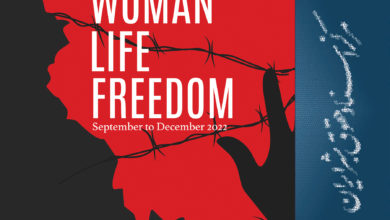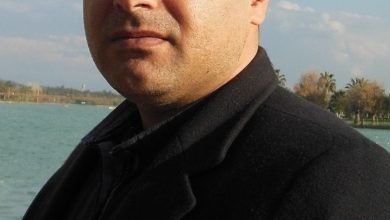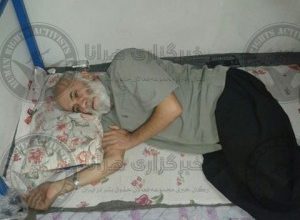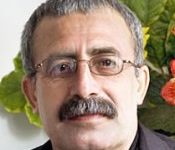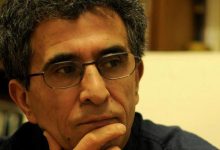Interview with Abulhassan Bani Sadr
Bani Sadr expands on whether or not he functioned as Ayatollah Khomeini’s advisor in the early years following the Iranian Revolution of 1979 and discusses his role as President and Commander in Chief in taking military action in Iran’s Kurdish regions in 1980. He also acknowledges the responsibility of Ayatollah Sadegh Khalkhali, the head of the newly formed Islamic Revolutionary Court in 1979, in perpetrating serious human rights abuses in Iran’s Kurdish region. The interview serves as an accompaniment to “Haunted Memories: The Islamic Republic’s Executions of Kurds in 1979” – IHRDC’s detailed account of the unlawful summary trials and executions that took place in Sanandaj, Mariwan, Saqqez and other predominantly Kurdish towns in northwestern Iran in August and September of 1979.
Name: Abulhassan Bani Sadr
Occupation: Former President of the Islamic Republic of Iran
Interviewing Organization: Iran Human Rights Documentation Center (IHRDC)
Date of Interview: March 3, 2011
Interviewer: IHRDC Staff
This interview was approved by Abulhassan Bani Sadr on March 3, 2011.
Q: Thank you, Mr. Bani Sadr, for agreeing to meet and speak with us today.
A: You are welcome.
Q: Were you Khomeini’s Advisor when he issued the fatwa of August 19 [1979] about the Kurds?1
A: No. I was on my way [to another location] when I heard he had issued that order so I told the driver to turn around and go to Ghom instead. I asked him ‘What is this order you have signed? People don’t think of you as His Royal Highness, but instead a spiritual highness. This is like descending from heaven and landing on earth and becoming the Commander in Chief. He said that “If I had not ordered [as] such, the military men would not have carried out [the order]”. I said “so what if they wouldn’t? Whatever the effects of that were, it could not be more harmful than what you did.” And thus I protested that order. The problem is that when Khomeini has issued an order like that, it means that there was a war there [in Kurdistan] and one cannot close one’s eyes on those who started the war and say that it was their right to start such a war. Yet, the other side didn’t have a right [to order the army], and in fact both sides were wrong. Many things can be accomplished without starting a war and there was no need to start a war.
Q: We read that you were Khomeini’s advisor. So were you not an advisor at that time… or were you before that?
A: I wasn’t an advisor. They said so… journalists wanted to imply that the person they have talked to was informed and was Imam’s advisor and gave such titles but I wasn’t an advisor. Nor did I ever insist on being his advisor. I became aware of issues or formed an opinion on them and let him know [what my opinion was], but it wasn’t like I was there [with him] all the time and waited for an issue to come up so that he could ask my opinion on it. It wasn’t like that.
[1] It should be noted that Bani Sadr was not president when Khomeini issued the fatwa. Bani Sadr was elected president of the Islamic Republic of Iran on January 25, 1980. Also, the fatwa was in fact dated the 18th of August 1979, not the 19th, however the content of the fatwa was published in Iranian newspapers on the 19th. In his fatwa Khomeini ordered Iran’s armed forces to advance towards the Iranian border town of Paveh within 24 hours to put an end to the unrest there, or else Khomeini vowed to “deal with them in a revolutionary manner”. See Farman-i Imam bih Unvan-i Ra’is-i Kull-i Quva Darbarihyih Havadis-i Paveh [Order of Imam as Commander in Chief Regarding the Events in Paveh], KAYHAN, [Aug. 18, 1979], available at http://www.iranhrdc.org/english/human-rights-documents/3507-1979-newspapers.html.
Q: Then who was his advisor?
A: He wasn’t a man who liked to be advised to seek advisors. It depended on situations! People imposed their opinions on him. He usually didn’t initiate. In fact he never initiated in his life. He always reacted. So people [tried to] excite a reaction in him. At that time, there were people who thought that the armed forces must be governed by the clerics so that they could take over the government. [These people] excited him [by telling him] that commanding the armed forces is an important position and must be his. So they incited him to issue that order.
Q: Where did Imam get his information about Kurdistan from?
A: A group that later came to be known as Sepah Intelligence (this is before Sepah was formed or VAVAK was created). They were the main informers. But aside from them were people who were from Kurdistan and were against Komala2 or KDP 3 and their control over Kurdistan. The government officials did the same thing. For example Mr. Gharazi was Deputy Provincial governor. He came to Tehran and spoke in the Revolutionary Council and said, “Consider Kurdistan lost!” Imagine saying this to Imam, a reactionary. When he said this in the Revolutionary Council, I said, “Sir, what is this nonsense you are saying? What do you mean Kurdistan is lost? Kurds founded Iran. How can Kurdistan be lost? Don’t you go and say such things to Mr. Khomeini so he is excited into reacting and an irreparable problem happens.” There were people like this too who gave certain reports to him. I know [Khomeini] at least had those three sources. He also had a representative who was a cleric. If I remember correctly his name was Mr. Amini. He negotiated with the Kurds then reported to [Khomeini]. As far as I know his reports did not incite [Khomeini’s] anger and were mostly for the purpose of resolving the matter.
Q: In March of 1979 the KDP committee gave you the 6 point plan for autonomy but the plan was rejected by the Revolutionary Council.4 For what reason did the Revolutionary Council reject the order?
A: Your information is wrong. They suggested the 6 points and sent a committee to me and said any changes you make, we agree with. Mr. [Dariush] Forouhar was accepted by them as a go between so that we could agree on a text. Mr. Forouhar gave me the text and the Revolutionary Council approved it and I announced the approval twice. But those who didn’t want [the approval]… and autonomy was their excuse and in reality were after something else, they started their war. I announced the approval twice, once in Tehran and another time in Ahvaz. The newspapers can be found as well as the publications of the KDP that reflect it. I also wrote [about this] in an editorial in Enghelab-e Eslami.
[2] Komala, or Sazman-i Inqilabiyih Zahmatkishan-i Kurdistan-i Iran (the Organization of Revolutionary Toilers of Iranian Kurdistan) is a leftist political organization founded by Kurdish activists. The party formally announced its existence following Iran’s revolution in 1979.
[3] KDP refers to the “Kurdish Democratic Party” which was founded in Mahabad, Iran on August 16, 1945. The group was later forced underground and then re-branded in the 1950s and renamed as the “Democratic Party of Iranian Kurdistan” (PDKI or KDPI). The KDPI was considered moderately left-wing and, with the exception of the time period in 1946 in which the Republic of Mahabad was established, advocated autonomy for Kurdistan within a democratic Iran..
[4] Following the Iranian Revolution, in the year 1979, several plans for increased Kurdish political autonomy within the Iranian state were proposed by Kurdish representatives to representatives of Ayatollah Khomeini.
Q: When you became the president you were the Commander in Chief. What role does the president play, as the Commander in Chief, in the security of the country?
A: The provision of external security for the country is the job of the army which is naturally under the supervision of the Commander in Chief. Also there is internal security, which is not the job of the military but that of the Ministry of Interior. At the time it was the police, Komiteh’s, and the Gendarmerie and on the political end, the Sepah. Sepah was under the supervision of the president but they didn’t really follow the commands of the president and instead heeded those of Khomeini. However, the Police and Gendarmerie were under the control of the Ministry of Interior and governed by him.
Q: What was your role?
A: If war started I had to prepare the Iranian forces for defending Iran. The war that took place in Kurdistan… as the Commander in Chief… because it was connected to a potential attack of Iraq on Iran… the role of the president was that he had to end the war as quickly as possible. Once we prevented those who had started the war from getting what they wanted, we announced a cease fire. We ended the war in Kurdistan before Iraq attacked Iran. If this had not been done and if the war had not ended quickly, Iran would be in definite danger because a portion of the forces were involved in Kurdistan and we didn’t have enough manpower to push back the invading forces.
Q: So your orders at the time, when you ordered the armed forces, that was due to threat from foreign invasion?
A: It has been 30 years since the Kurds made up a lie saying that Bani Sadr said ‘don’t take off your boots’ [until you have crushed the Kurds]. They have repeated it so often that I started doubting whether or not I said the statement. (Bani Sadr reads the newspaper presented to him by interviewers). As it is reflected here in the paper, the issue had nothing to do with Kurdistan. A group took a bunch of civilians and military personnel hostage and I told the armed forces don’t take your boots off until the hostages are released. It had nothing to do with Kurdistan. In fact, once I was [at a speaking engagement] in Germany and the Kurds asked me why I had said this statement. So I read them the text and said: why have you been spreading lies for 30 years? Of course they had no answers. After the Revolutionary Council approved of autonomy, they had no other excuses and for that reason, they made up those lies because their true identity was exposed. Because the Revolutionary Council approved the plan and the war was nonsensical and we had to act. They wanted autonomy and we agreed. War no longer made any sense!
Q: What was your economic and cultural plan for Kurdistan?
A: Iranian society has many ethnicities and each ethnicity has an identity and this ethnic identity must be recognized. Cultural matters should be handled by Kurdish society. I held, and still hold the position that the issues of Iran should be definitely resolved based on three rights. One would be the right to differ, which is a human right, meaning the right to hold a different identity. Another would be the right to participate: which means they are part of Iran and partake in it along with everyone else. I even went as far as saying in democracy one person is one vote, so democracy is not ethno-centric. In a country where certain specified ethnic groups live, if ‘one person, one vote’ remains as the only basis, well the Fars and Turk ethnicities have the larger populations and therefore, those in minority will forever remain minorities. So a measure of compensation has to be made so they can participate in the governing of the country as part of their right of participation. The third would be the right to peace… where a society with such rights and differences can coexist in peace. So the economic, political and cultural growth has to be equal for everybody and an office has to exist to keep this peace and if an ethnicity is wronged, the office is able to sort it out […] Later when we left Iran and organized the National Council for Resistance, we produced a plan for autonomy and Mr. Ghassemlou5 who was a member of the Council at the time signed the plan. Therefore we have a clear policy for dealing with the situation in Iran.
Q: As you just said, you were opposed to the war in Kurdistan, so who was issuing the orders? The Army and Sepah and Basij all attacked Kurdistan. You were the Commander in Chief so who was issuing these orders?
A: The war in Kurdistan… I mean the KDP published a text stating that the war in Kurdistan was instigated by the Komala. Now why they did that… considering autonomy was approved at that time is a question that has not been answered so far. They attacked the military garrisons that passed through Sanandaj. Going back; during the first fights, in the early days of the Revolution, they clashed using arms and disarmed the Gendarmerie. They attacked the military head quarters and many of them were arrested. We went to Sanandaj. There, by my suggestion, the different groups came to an agreement over a draft, which called for elections in Sanandaj and that a council be formed… and when the results of their work was tried and tested, the same should be done across Kurdistan. The election took place and eleven people were voted in. Two were from Komala, one from KDP, and eight from other parties and groups. This was the city council. Then the Komala members threw grenades at their houses and threatened them to leave the city. Although the deal was that armed people were to leave the city and I had ordered Sepah to leave the city as well, the Komala armed men came to the city and attacked the military garrison and then shot at the military headquarters. We chose some intermediaries including Jalal Talebani who is now the President of Iraq. He told them that what I had said is a historic opportunity for them, that they should not let it slip away so easily and become pawns in the hands of Saddam [Hussein]. They didn’t listen. Then Eric Rouleau who was a journalist at Le Monde and later became the French Ambassador in Tunisia and Turkey and is retired now came to me and said, “But [I thought that] you were in favor of autonomy!”’ I said, “I still am in favor of it but they don’t want autonomy.” He went to Kurdistan and spoke with them, and then went to Iraq and then Paris. He then called me and said that I was right and that they [the Kurds] had other things in mind.
[5] Abdul Rahman Ghassemlou was the Secretary-General of the Democratic Party of Iranian Kurdistan (KDPI) for 16 years until his assassination in 1989 by emissaries of the Islamic Republic of Iran.
Q: In your opinion, what did they want?
A: If you want the exact details you should ask the Americans to give you the documents of the Iraqi intelligence regarding Kurdistan. Everything is there. In fact, you can ask where they got their arms from! It is not like you can find arms in the wilderness! Someone was giving the arms to them. If you were to pay attention you realize that when they started waging their war in Sanandaj it was a few months before the offensive of Iraq against Iran. If we did not end the war, the possibility existed for Iran to fall. Also Rolan Shebri, who is originally Iraqi and wrote an article in Maghreb Mashregh in 1981, stated that Saddam intended to solve the “Kurdish issue” through massacre. I think this had a direct connection with the attack on Iran. The British government’s documents state that from a few months prior to the attack on Iran, Iraq had called upon their army reserve to prepare them for battle. Similarly, the Nojeh Coup was also prepared from months before… when that was discovered it was the military that suffered and fell apart.6 The war they started had nothing to do with autonomy because autonomy was approved by the Revolutionary Council and I had announced it too.
[6] The Nojeh Coup, of July 11, 1980, refers to an attempt by the former prime minister of Iran, Shapour Bakhtiar to overthrow the newly established Islamic Republic of Iran and government of Ayatollah Khomeini and Abulhassan Bani Sadr.
Q: How many times did you travel to Kurdistan?
A: In the beginning I went to Sanandaj and we established the [city] Council and everyone signed it. That was my only trip to Sanandaj.
Q: [Reading out] …here is an announcement by the KDP in April or May of 1980 that states a caravan entered Iran through Iraq. It was stopped… it was carrying arms that were brought from Iraq into Iran. At that time the war hadn’t started yet and they [the KDP] considered themselves to be protectors of the borders. They said that Komala and Sheikh Ezzedin Hosseini7 intervened. The head of the caravan was a man by the name of Jalal Hosseini and he said that Sheikh Ezzedin and Komala were aware of these arms and they intervened and got the arms from them…
A: So this document says that the money and arms came from Iraq. The most complete document is the one that the Iraqi intelligence has. Everything is there about who was given money or arms. I mean by the Saddam regime.
Q: What is your opinion about what [Ayatollah] Khalkhali did in Kurdistan?
A: They were crimes. I said it back then too so it’s not like I am only saying it now. I said it in Enghelab-e Eslami newspaper and then in the Assembly of Experts that had been formed at the time. One of the cases publicized in a European magazine described an old man taken to the gallows on a stretcher. He couldn’t even walk. Khalkhali shot him by firing squad. [The victim] was a Kurdish Khan accused of being somebody important during the Shah’s time. Those things that Khalkhali did were criminal. In Gharna too, when they went into a Kurdish village and committed crimes… I even wrote an opinion piece in Enghelab-e Eslami called “A Requiem for Gharna”.
Q: In June 2, 1980 you said in a speech that according to a poll people in Kurdistan want security and a better economic situation. Where is this poll?
A: If I said that then the newspapers of the time probably published the poll. Otherwise how could I have said it?
[7] Sheikh Ezzedin Hosseini was a Kurdish spiritual leader and the Friday Prayer leader in Mahabad who led protests against the Shah’s government in the lead up to the Iranian Revolution in 1979. In the early years following the Revolution, Sheikh Ezzedin was a principal negotiator on behalf of Iran’s Kurdish minority.


